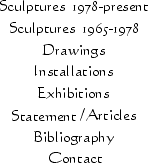| 
Better Living Through Alchemy
ArtsBeat, Express, March 12, 1999
by Jack Foley
Running your hands along these cool, brightly colored surfaces is like touching the skin of a fantastic animal. You notice the enormous energy, the color, the playfulness. They are like a convocation of rainbows. Bearing deliberately enigmatic titles like Zebulon, Zongo, and Cotopoxi, the sculptures twist and write in all directions; their surfaces are alive with colorful shapes and drawings.
 The artist, Joseph Slusky, is a small, powerfully built man who was once a gymnast who maintains a permanent twinkle in his eye. He talks in an animated, almost breathless way about his work. "I grew up with metal toys-lead soldiers from England. I think of these as my own toy line." The artist, Joseph Slusky, is a small, powerfully built man who was once a gymnast who maintains a permanent twinkle in his eye. He talks in an animated, almost breathless way about his work. "I grew up with metal toys-lead soldiers from England. I think of these as my own toy line."
DETOXING TOYOTAS
Slusky's sculptures are indeed a little like what children used to produce with erector sets and Tinker Toys; they are dizzy with planes, angles, and sudden movement. They're often funny, but they can be deeply touching too. "They need light, light, light" says Slusky, as if they were a forest of trees, "so you can see the color." They invite you to touch them, and in the exhibit space of the Oakland Museum's sculpture court at the City Center, you can touch them. "They're wacky," says Slusky, "but they're socially acceptable. They're civil."
 Slusky's work is like what might be produced by an abstract painter, who instead of working with canvas, paints his picture on the planes and angles of sculpture. Slusky's work is like what might be produced by an abstract painter, who instead of working with canvas, paints his picture on the planes and angles of sculpture.
 For more than thirty years Joseph Slusky has fabricated polychrome metal sculptures. His sources include constructivism and surrealism as well as Bay Area funk. He describes his work as "cogitations on detritus": "As a child in LA I went to auto shows, not museums. Eventually I got involved with sculpture via bodywork. The metal in this show was all waste, on its way to being Toyotas. I'm trying to detox Toyotas." For more than thirty years Joseph Slusky has fabricated polychrome metal sculptures. His sources include constructivism and surrealism as well as Bay Area funk. He describes his work as "cogitations on detritus": "As a child in LA I went to auto shows, not museums. Eventually I got involved with sculpture via bodywork. The metal in this show was all waste, on its way to being Toyotas. I'm trying to detox Toyotas."
 Slusky has taught for many years at UC Berkeley and elsewhere in the Bay Area, but there is nothing academic about his style. Quoting the poet Charles Olson, he says, "This is 'how to dance sitting down'; this is birthing". Slusky has taught for many years at UC Berkeley and elsewhere in the Bay Area, but there is nothing academic about his style. Quoting the poet Charles Olson, he says, "This is 'how to dance sitting down'; this is birthing".
PETALS ON THE METAL
As he works on his pieces, Slusky enters a "trance space," embarking upon "an inner journey." What he discovers there is a total transformation of the scraps he began with; the metal comes alive with possibilities "isn't all art alchemy?" he asks.
 The pieces he carefully shapes are painted, with enormous attention to detail and with many flecks, squiggles, and oddities adorning the base color. Once that is done, the artist will often cover the entire piece with black paint, which is then removed with light sandpaper, leaving speckles of black throughout. The works are at once extraordinarily orderly and at the same time, because of their colors and shapes, riotously imaginative. "I'm creating my own junkyard," says Slusky. "I'm drawing in space." The pieces he carefully shapes are painted, with enormous attention to detail and with many flecks, squiggles, and oddities adorning the base color. Once that is done, the artist will often cover the entire piece with black paint, which is then removed with light sandpaper, leaving speckles of black throughout. The works are at once extraordinarily orderly and at the same time, because of their colors and shapes, riotously imaginative. "I'm creating my own junkyard," says Slusky. "I'm drawing in space."
 Slusky's remarks offer valuable insights into his working methods and his conception of art, but they fade away in the experience of the work itself. As we look at these marvelous objects, and as we touch them, we are transported-carried off. They project us into spaces that are all movement and color: we are suddenly children looking at a world of light, color, and space. Another great sculptor, Jean Dubuffet, would have called Slusky's pieces edifices-buildings for the spirit-or, in poet Andy Brumer's phrase, "wholly inhabitable dwelling places for the soul." Slusky's remarks offer valuable insights into his working methods and his conception of art, but they fade away in the experience of the work itself. As we look at these marvelous objects, and as we touch them, we are transported-carried off. They project us into spaces that are all movement and color: we are suddenly children looking at a world of light, color, and space. Another great sculptor, Jean Dubuffet, would have called Slusky's pieces edifices-buildings for the spirit-or, in poet Andy Brumer's phrase, "wholly inhabitable dwelling places for the soul."
 Isn't all art alchemy? Isn't all art alchemy?
|

